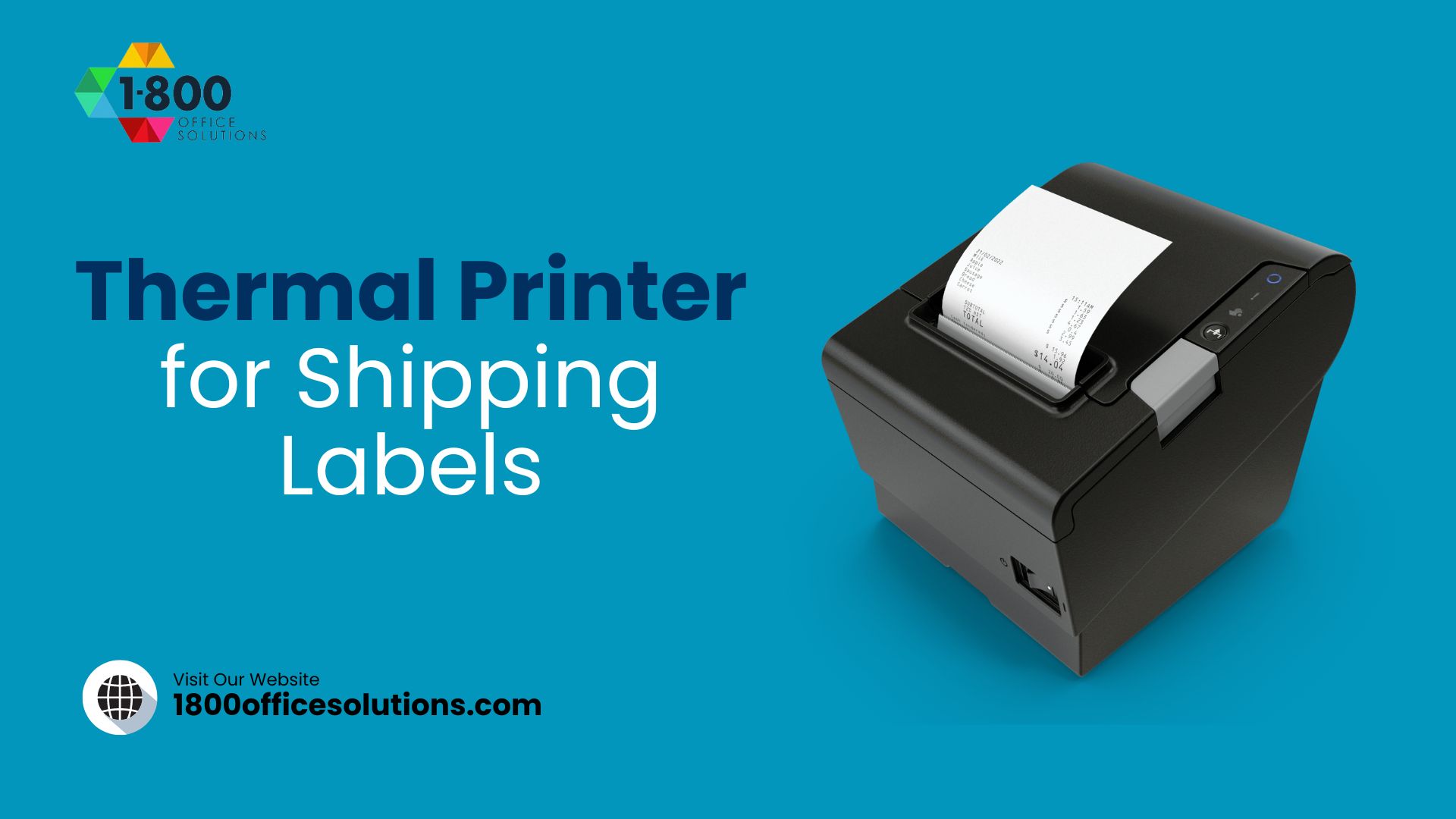What Is the Best Thermal Printer for Shipping Labels?
Thermal Printer for Shipping Labels
Thermal label printer for shipping used for labeling. Unlike traditional printers that rely on messy ink cartridges, these innovative devices utilize heat to create crisp, legible labels on demand. This thermal printing process involves a printhead strategically heating specific areas of specially coated paper, causing a chemical reaction that darkens the designated sections, forming the desired text and graphics.
Choosing the right thermal label printer for your shipping needs is crucial for maximizing efficiency and streamlining your workflow. There are several factors to consider, from print volume and speed to connectivity options and media handling capabilities. Additionally, understanding the two main types of thermal printers, direct thermal and thermal transfer, will help you select the one best suited for your specific label requirements.
While both methods leverage heat for printing, direct thermal utilizes heat-sensitive paper that reacts directly to the printhead. Thermal transfer, on the other hand, employs a ribbon alongside the heat-sensitive paper, creating a more durable and permanent image.
What are Thermal Shipping Label Printer?
When it comes to shipping for your small business, efficiency is key. Thermal printers specifically designed for shipping packages can be a game changer. These label printers use heat to print directly onto 4×6 thermal labels, eliminating the need for messy ink cartridges.
With features like Bluetooth connectivity, you can even print shipping labels wirelessly from your phone or computer, saving valuable time. Look for a wireless shipping label printer to streamline your packaging process and keep your small business running smoothly.
How Thermal Printers Work?
As mentioned earlier, thermal printers rely on the magic of heat to create labels. The printhead, essentially a tiny array of heating elements, selectively applies heat to specific areas of the thermal label. This heat triggers a chemical reaction within the specially coated paper, darkening those sections and forming the image you see on the finished label.
There are two primary types of thermal printers commonly used for shipping labels: direct thermal and thermal transfer. Direct thermal printers work directly with heat-sensitive paper, offering a cost-effective solution for applications where labels don’t require extreme durability.
In contrast, thermal transfer printers use a ribbon alongside the heat-sensitive paper, resulting in a more permanent and resistant image suitable for harsh environments or labels that need to withstand extended periods.
Benefits of Using Thermal Printers for Shipping Labels
Thermal printers offer a multitude of advantages for businesses of all sizes, particularly those involved in frequent shipping activities. Their fast thermal printing speeds enable you to generate labels quickly and efficiently, keeping your workflow moving smoothly.
Furthermore, unlike traditional inkjet or laser printers, thermal printers eliminate the need for messy ink cartridges, translating to cost-effective operation. The labels themselves are typically clear and durable, ensuring your shipping information remains legible throughout the delivery process. Additionally, their compact size makes them ideal for space-constrained work environments.
Key Factors to Consider When Choosing
Selecting the ideal thermal printer for your shipping needs requires careful consideration of several crucial factors. Here’s a breakdown of the key elements to ponder:
Print Volume and Speed
The first step is to assess your average daily or weekly shipping volume. This will help you determine the printer’s capacity to handle your workload efficiently. Thermal printers boast varying print speeds, measured in labels per minute (LPM). If you ship a high volume of packages daily, a printer with a faster LPM rating is essential to maintain a smooth workflow. Conversely, for businesses with occasional shipping needs, a slower printer might suffice.
Label Compatibility
Thermal label printers come designed to work with specific label sizes. Standard label sizes like 4×6 inches are widely available, but some printers might have limitations on the maximum label width they can accommodate. Double-check the printer’s specifications to ensure it aligns with the label size you plan to use for your shipping needs.
Connectivity Options
Thermal label printers offer various connection options to integrate seamlessly with your existing workflow. The most common method is a simple USB connection that allows you to plug the printer directly into your computer.
For a more flexible setup, consider printers with Wi-Fi connectivity, enabling wireless printing from any device on your network. Additionally, some models boast Bluetooth connectivity, ideal for pairing with mobile devices for on-the-go label printing convenience.
Resolution (DPI)
Print resolution, measured in dots per inch (DPI), determines the sharpness and clarity of your printed labels. While the standard resolution for shipping labels is typically 203 DPI, opting for a printer with 300 DPI might be preferable for applications requiring exceptional barcode clarity.
Higher resolution translates to more intricate details and sharper barcodes, crucial for accurate scanning during the shipping process.
Media Handling
Thermal printers come in two primary media handling configurations: roll-fed and fanfold. Roll-fed printers utilize continuous rolls of labels, offering a cost-effective option for high-volume printing. However, they might require more frequent media changes.
Fanfold printers, on the other hand, use pre-cut stacks of labels, simplifying loading and unloading but potentially increasing label costs per unit. Some advanced models boast automatic label loading features, further streamlining the printing process.
Durability and Maintenance
The printer’s build quality and warranty directly impact its longevity and performance. Consider opting for a model with a robust construction to withstand frequent use. Additionally, ease of cleaning and maintaining the printhead is crucial. Regular cleaning ensures optimal print quality and extends the lifespan of your thermal printer.
Software Compatibility
Seamless integration with your existing shipping software or platform is paramount. Ensure the thermal printer you choose is compatible with your preferred software. Additionally, verify that the printer has the necessary drivers available for your operating system to guarantee smooth operation.
Top Thermal Printer Options for Shipping Labels
Having explored the key considerations, let’s delve into some of the top-rated thermal printer options for various needs:
Top-Rated Desktop Thermal Printers
-
Rollo USB Shipping Label Printer: This commercial-grade thermal printer boasts exceptional reliability and is a popular choice for small and medium-sized businesses. It features a USB connection for easy setup and integration with your computer. The fast print speed of up to 4 inches per second ensures you can generate labels swiftly, keeping your shipping workflow efficient. Additionally, the Rollo printer is compatible with all major shipping platforms like USPS, FedEx, and Shopify, simplifying label creation.
-
MUNBYN Wireless/USB Thermal Label Printer: This versatile option offers both USB and Bluetooth connectivity, providing flexibility in how you connect the printer to your system. The MUNBYN printer boasts a user-friendly design and is particularly well-suited for businesses that require on-demand label printing from smartphones or tablets. It supports a wide range of label sizes, including the industry-standard 4×6 inch format, making it adaptable to various shipping needs.
Top-Rated Industrial Thermal Printers
For high-volume shipping operations, industrial thermal printers offer the robustness and speed to handle demanding workloads. One such option is the Zebra ZT420 Industrial Label Printer. This powerhouse boasts lightning-fast print speeds and a durable metal construction built to withstand continuous use. The ZT420 also features advanced media handling capabilities for various label sizes and thicknesses.
It’s important to note that industrial thermal printers are typically a significant investment compared to desktop models. Carefully evaluate your printing volume and budget before making a decision.
Top-Rated Mobile Thermal Printers
For businesses requiring on-the-go label printing solutions, mobile thermal printers offer unparalleled convenience. JADENS Bluetooth Thermal Shipping Label Printer is a compact and lightweight option that effortlessly connects to your smartphone or tablet via Bluetooth. This portable powerhouse allows you to print labels directly from your mobile device, streamlining your shipping process wherever you are.
Several other mobile thermal printer options are available, offering varying features and functionalities. Consider factors like size, weight, and battery life when selecting the best mobile printer for your needs.
Additional Considerations
While print speed, connectivity, and media handling are crucial factors, other considerations can influence your decision:
-
Replacement Label Costs: While thermal printers themselves are generally cost-effective, the ongoing cost of thermal labels needs to be factored in. Direct thermal labels are typically less expensive than thermal transfer labels, but they might not offer the same level of durability. Evaluate your labeling needs and choose the most cost-effective option that meets your requirements.
-
Customer Support and Warranty Options: A reliable thermal printer warranty provides peace of mind in case of any malfunctions. Additionally, robust customer support ensures you have access to assistance if you encounter any technical difficulties.
-
Energy Efficiency of the Printer: Energy efficiency is an increasingly important factor. Look for printers with Energy Star certification or features like automatic sleep mode to minimize their environmental impact and potentially reduce your energy bills.
What People Also Ask
What is the difference between direct thermal and thermal transfer printing?
Both methods utilize heat for printing, but they differ in the printing process. Direct thermal printers use heat-sensitive labels that react directly to the printhead, creating the image. Thermal transfer printers, on the other hand, employ a ribbon alongside the label. The heat from the printhead melts the ribbon onto the label, resulting in a more durable and permanent image.
Can thermal printers print in color?
While some industrial thermal transfer printers offer limited color printing capabilities, most thermal printers primarily function in black and white. For situations requiring color labels, traditional inkjet or laser printers might be a better option.
How long do thermal labels typically last?
The longevity of thermal labels depends on the type and storage conditions. Direct thermal labels can generally last for several months under normal conditions, but exposure to sunlight or extreme heat can accelerate fading. Thermal transfer labels offer superior durability and can last for years, making them ideal for applications requiring long-lasting labels.
What are some maintenance tips for thermal printers?
Regular cleaning of the printhead is essential to maintain optimal print quality. Most manufacturers provide cleaning kits or instructions for proper maintenance procedures. Additionally, using high-quality thermal paper recommended by the printer manufacturer can help extend the lifespan of the printhead and ensure smooth operation.
Conclusion
Selecting the ideal thermal printer for your shipping needs requires careful consideration of various factors. By understanding the different types of printers, their functionalities, and the key buying considerations, you can make an informed decision.
Remember, the best thermal printer for you depends on your specific volume, budget, and printing requirements. Equip yourself with the knowledge, and happy printing!











